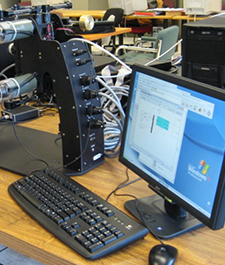Research
 Our research group has a strong background and expertise in dynamics, robotics and haptics, solid mechanics, modelling and analysis, mechatronics and control, computational methods, and algorithms.
Our research group has a strong background and expertise in dynamics, robotics and haptics, solid mechanics, modelling and analysis, mechatronics and control, computational methods, and algorithms.
The lab possesses a versatile, mechatronic testbed to carry out experimental work for a broad range of research topics in dynamics, robotics, haptics and mechatronics. There are also multiple workstations available for analysis and simulation.
Our current research projects can be grouped into the three main themes described below.
Multibody systems, contact and analytical mechanics
Dynamic modelling, simulation and analysis play an increasingly important role in many strategic areas of industry and technology development. In our work, we address some fundamental problems in these areas that are of particular importance in industrial applications of dynamic models, analyses, physics-based simulation, and virtual environments. Our focus is the dynamics of mechanical systems with time varying topology, constraints, and contacts. We employ main concepts from analytical mechanics, continuum mechanics, operational research, and computer science to carry out our research. We address the unified development and evaluation of dynamics models and algorithms for finite dimensional mechanical systems capable of large rigid body motion. An important aspect is the analysis of the connection between the mathematical model stemming from the dynamics representation and the real physical behaviour of the system. Several significant modelling and analysis challenges are addressed. The role and representations of friction are also studied.
Haptic and robotic systems
Humans traditionally exchange information and communicate with their physical environment via their five senses: hearing, sight, touch, smell, and taste. Haptic interaction generally refers to the sense of touch, and requires the transmission of direct physical contact (e.g., forces or tactile sensation). This usually relies on instrumented mechanical devices to serve as haptic interfaces between the human and the digital world. In our work we particularly focus on interactions where the direct transmission of force from a digital representation to the human via a robotic device is the main element. Application of such systems is rapidly increasing in many areas of industry and everyday life. Examples include hand-based interactions with virtual environments represented via dynamic simulations, such as training simulators, virtual prototyping environments, and rehabilitation systems. Our research is mainly concerned with exploring how the properties of articulated mechanical systems, the principles of mechanics, and computational dynamics can be used to improve haptic performance, address the core problems in haptic contact, and develop innovative solutions and novel concepts.
We are also working on developing open-source, portable and affordable haptic displays. This sub-project is called Haply and aims to democratize haptic technologies and make them more accessible. You can find more information here.
Rover systems
Wheeled mobile robots operating on unstructured terrain play an important role in many applications. In this research area, we aim to develop advanced methods, models and tools to assist in the design, control and operation of such robotic systems. An important part of the work is the development of a complete set of representative models, related algorithms and implementations to characterize the dynamics and the coupling of rover-terrain systems. These models will be specially developed to provide information to the engineer for the solution of typical design, control and operation tasks for mobile robots and for the understanding of the effects of relevant design parameters on their performance. The models will also be used to characterize traction and mobility, actuation systems and mechanisms. A central element is related to the description and characterization of wheel-terrain interaction and wheel slippage on soft terrain and to the simplified representation of soil dynamics. These representations are also established so that they can be used in the state estimation and control system development of rovers. Algorithms are being developed for parametric analysis and for on- and off-line identification of parameters. Larger-scale experiments are also designed and performed to validate the proposed methods and models.
